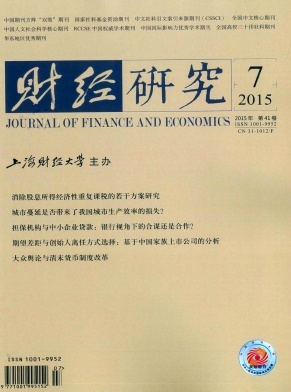工资、生产效率与企业出口——基于单位劳动力成本的分析
财经研究 2015 年 第 41 卷第 07 期, 页码:
摘要
参考文献
摘要
在劳动力供给下降、工资逐年上涨的背景下,生产效率提高的幅度超过工资上涨的幅度会导致单位劳动力成本的下降,这意味着制造业整体竞争力得以提升,从而可以激励工业企业更重视国内市场的开拓。文章综合工资和生产率因素,以单位劳动力成本衡量企业的竞争力,基于1998-2007年中国工业企业的面板数据,研究了单位劳动力成本对制造业企业出口密集度的影响。面板固定效应模型和Tobit模型的估计结果显示,单位劳动力成本对企业出口密集度存在显著的正向影响,即单位劳动力成本的下降会抑制企业出口,企业会降低出口密集度并增加产品在国内市场的份额。Heckman选择模型两步法也表明,单位劳动力成本对企业出口的集约边际和扩展边际均存在显著的正向影响,单位劳动力成本下降会导致企业减少出口倾向和出口密集度。
[1]包群,邵敏. 出口贸易与我国的工资增长:一个经验分析[J]. 管理世界,2010,(9):55-66.
[2]任志成,戴翔. 劳动力成本上升对出口企业转型升级的倒逼作用——基于中国工业企业数据的实证研究[J]. 中国人口科学,2015,(1):48-58.
[3]孙楚仁,田国强,章韬. 最低工资标准与中国企业的出口行为[J]. 经济研究,2013,(2):42-54.
[4]孙楚仁,张卡,章韬. 最低工资一定会减少企业的出口吗?[J]. 世界经济,2013,(8):100-124.
[5]王燕武,李文溥,李晓静. 基于单位劳动力成本的中国制造业国际竞争力研究[J]. 统计研究,2011,(10):60-67.
[6]魏浩,郭也. 中国制造业单位劳动力成本及其国际比较研究[J]. 统计研究,2013,(8):102-110.
[7]文东伟,冼国明,马静. FDI、产业结构变迁与中国的出口竞争力[J]. 管理世界,2009,(4):96-107.
[8]周宇. 中国是否仍然拥有低劳动力成本优势?[J]. 世界经济研究,2014,(10):3-8.
[9]Black S E, Lynch L M. Humancapital investments and productivity[J]. The American Economic Review, 1996, 86(2): 263-267.
[10]Ceglowski J, Golub S. Just how low are China’s labour costs?[J]. The World Economy, 2007, 30(4): 597-617.
[11]Ceglowski J, Golub S S. Does China still have a labor cost advantage?[J]. Global Economy Journal, 2012, 12(3): 1524-5861.
[12]Chen V W, Wu H X, Van Ark B. More costly or more productive? Measuring changes in competitiveness in manufacturing across regions in China[J]. Review of Income and Wealth, 2009, 55(s1): 514-537.
[13]Edwards L, Golub S S. South Africa’s international cost competitiveness and exports in manufacturing[J]. World Development, 2004, 32(8): 1323-1339.
[14]Griliches Z. Issues in Assessing the contribution of research and development to productivity growth[J]. The Bell Journal of Economics, 1979, 10(1): 92-116.
[15]Haskel J E, Pereira S C, Slaughter M J. Does inward foreign direct investment boost the productivity of domestic firms?[J]. The Review of Economics and Statistics, 2007, 89(3): 482-496.
[16]Levinsohn J, Petrin A. Estimating production functions using inputs to control for unobservables[J]. The Review of Economic Studies, 2003, 70(2): 317-341.
[17]Li H, Li L, Wu B,et al. The end of cheap Chinese labor[J]. The Journal of Economic Perspectives, 2012, 26(4): 57-74.
[18]Mbaye A A, Golub S. Unit labour costs, international competitiveness, and exports:The case of Senegal[J]. Journal of African Economies, 2002, 11(2): 219-248.
[19]Pavcnik N. Trade liberalization, exit, and productivity improvements:Evidence from Chilean plants[J]. The Review of Economic Studies, 2002, 69(1): 245-276.
[20]Sasikumar S K, Abraham V. Labor cost and export behavior of firms in Indian textile and clothing industry[J]. Economics, Management, and Financial Markets, 2011, 6(1): 258-282.
[21]Van Dijk M. The determinants of export performance in developing countries:The case of Indonesian manufacturing[R]. Eindhoven Centre for Innovation Studies Working Paper, 2002.
[22]Wei Y, Liu X. Productivity spillovers from R&D, exports and FDI in China’s manufacturing sector[J]. Journal of International Business Studies, 2006, 37(4): 544-557.
[2]任志成,戴翔. 劳动力成本上升对出口企业转型升级的倒逼作用——基于中国工业企业数据的实证研究[J]. 中国人口科学,2015,(1):48-58.
[3]孙楚仁,田国强,章韬. 最低工资标准与中国企业的出口行为[J]. 经济研究,2013,(2):42-54.
[4]孙楚仁,张卡,章韬. 最低工资一定会减少企业的出口吗?[J]. 世界经济,2013,(8):100-124.
[5]王燕武,李文溥,李晓静. 基于单位劳动力成本的中国制造业国际竞争力研究[J]. 统计研究,2011,(10):60-67.
[6]魏浩,郭也. 中国制造业单位劳动力成本及其国际比较研究[J]. 统计研究,2013,(8):102-110.
[7]文东伟,冼国明,马静. FDI、产业结构变迁与中国的出口竞争力[J]. 管理世界,2009,(4):96-107.
[8]周宇. 中国是否仍然拥有低劳动力成本优势?[J]. 世界经济研究,2014,(10):3-8.
[9]Black S E, Lynch L M. Humancapital investments and productivity[J]. The American Economic Review, 1996, 86(2): 263-267.
[10]Ceglowski J, Golub S. Just how low are China’s labour costs?[J]. The World Economy, 2007, 30(4): 597-617.
[11]Ceglowski J, Golub S S. Does China still have a labor cost advantage?[J]. Global Economy Journal, 2012, 12(3): 1524-5861.
[12]Chen V W, Wu H X, Van Ark B. More costly or more productive? Measuring changes in competitiveness in manufacturing across regions in China[J]. Review of Income and Wealth, 2009, 55(s1): 514-537.
[13]Edwards L, Golub S S. South Africa’s international cost competitiveness and exports in manufacturing[J]. World Development, 2004, 32(8): 1323-1339.
[14]Griliches Z. Issues in Assessing the contribution of research and development to productivity growth[J]. The Bell Journal of Economics, 1979, 10(1): 92-116.
[15]Haskel J E, Pereira S C, Slaughter M J. Does inward foreign direct investment boost the productivity of domestic firms?[J]. The Review of Economics and Statistics, 2007, 89(3): 482-496.
[16]Levinsohn J, Petrin A. Estimating production functions using inputs to control for unobservables[J]. The Review of Economic Studies, 2003, 70(2): 317-341.
[17]Li H, Li L, Wu B,et al. The end of cheap Chinese labor[J]. The Journal of Economic Perspectives, 2012, 26(4): 57-74.
[18]Mbaye A A, Golub S. Unit labour costs, international competitiveness, and exports:The case of Senegal[J]. Journal of African Economies, 2002, 11(2): 219-248.
[19]Pavcnik N. Trade liberalization, exit, and productivity improvements:Evidence from Chilean plants[J]. The Review of Economic Studies, 2002, 69(1): 245-276.
[20]Sasikumar S K, Abraham V. Labor cost and export behavior of firms in Indian textile and clothing industry[J]. Economics, Management, and Financial Markets, 2011, 6(1): 258-282.
[21]Van Dijk M. The determinants of export performance in developing countries:The case of Indonesian manufacturing[R]. Eindhoven Centre for Innovation Studies Working Paper, 2002.
[22]Wei Y, Liu X. Productivity spillovers from R&D, exports and FDI in China’s manufacturing sector[J]. Journal of International Business Studies, 2006, 37(4): 544-557.
引用本文
王万珺, 沈坤荣, 叶林祥. 工资、生产效率与企业出口——基于单位劳动力成本的分析[J]. 财经研究, 2015, 41(7): 0.
导出参考文献,格式为:
下一篇:土地资本化和中国地区金融扩张





 7734
7734  4050
4050

